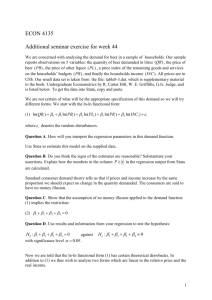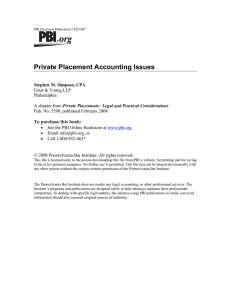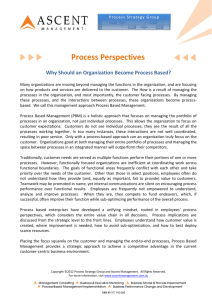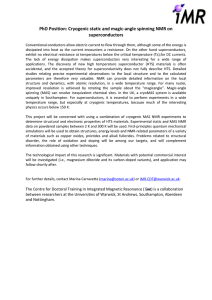HIGH-TEMPERATURE STEAM-TREATMENT OF PEEK, PEKK, PBI, AND THEIR BLENDS:
advertisement
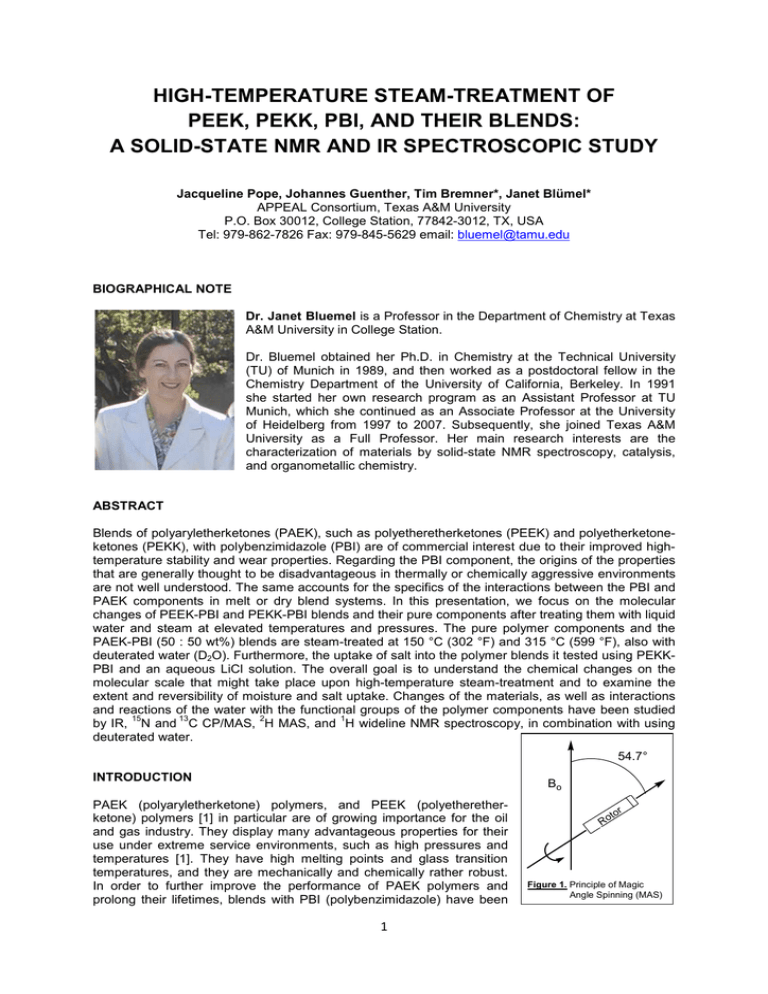
HIGH-TEMPERATURE STEAM-TREATMENT OF PEEK, PEKK, PBI, AND THEIR BLENDS: A SOLID-STATE NMR AND IR SPECTROSCOPIC STUDY Jacqueline Pope, Johannes Guenther, Tim Bremner*, Janet Blümel* APPEAL Consortium, Texas A&M University P.O. Box 30012, College Station, 77842-3012, TX, USA Tel: 979-862-7826 Fax: 979-845-5629 email: bluemel@tamu.edu BIOGRAPHICAL NOTE Dr. Janet Bluemel is a Professor in the Department of Chemistry at Texas A&M University in College Station. Dr. Bluemel obtained her Ph.D. in Chemistry at the Technical University (TU) of Munich in 1989, and then worked as a postdoctoral fellow in the Chemistry Department of the University of California, Berkeley. In 1991 she started her own research program as an Assistant Professor at TU Munich, which she continued as an Associate Professor at the University of Heidelberg from 1997 to 2007. Subsequently, she joined Texas A&M University as a Full Professor. Her main research interests are the characterization of materials by solid-state NMR spectroscopy, catalysis, and organometallic chemistry. ABSTRACT Blends of polyaryletherketones (PAEK), such as polyetheretherketones (PEEK) and polyetherketoneketones (PEKK), with polybenzimidazole (PBI) are of commercial interest due to their improved hightemperature stability and wear properties. Regarding the PBI component, the origins of the properties that are generally thought to be disadvantageous in thermally or chemically aggressive environments are not well understood. The same accounts for the specifics of the interactions between the PBI and PAEK components in melt or dry blend systems. In this presentation, we focus on the molecular changes of PEEK-PBI and PEKK-PBI blends and their pure components after treating them with liquid water and steam at elevated temperatures and pressures. The pure polymer components and the PAEK-PBI (50 : 50 wt%) blends are steam-treated at 150 °C (302 °F) and 315 °C (599 °F), also with deuterated water (D2O). Furthermore, the uptake of salt into the polymer blends it tested using PEKKPBI and an aqueous LiCl solution. The overall goal is to understand the chemical changes on the molecular scale that might take place upon high-temperature steam-treatment and to examine the extent and reversibility of moisture and salt uptake. Changes of the materials, as well as interactions and reactions of the water with the functional groups of the polymer components have been studied 15 13 2 1 by IR, N and C CP/MAS, H MAS, and H wideline NMR spectroscopy, in combination with using deuterated water. 54.7° INTRODUCTION Bo PAEK (polyaryletherketone) polymers, and PEEK (polyetheretherketone) polymers [1] in particular are of growing importance for the oil and gas industry. They display many advantageous properties for their use under extreme service environments, such as high pressures and temperatures [1]. They have high melting points and glass transition temperatures, and they are mechanically and chemically rather robust. In order to further improve the performance of PAEK polymers and prolong their lifetimes, blends with PBI (polybenzimidazole) have been 1 Ro tor Figure 1. Principle of Magic Angle Spinning (MAS) developed. However, in contrast to the pure PAEK components, the PBI addition leads to a more complex interaction of the blend with aqueous systems, for example water and steam [2], and salt solutions. A better understanding of the interactions of water with the functional groups of the PBI component at the molecular level is necessary. Using molecular model compounds mimicking PBI, the literature discusses mainly two ways in which water could reside in PBI [3]: it can either be present in larger aqueous domains nestled between the PBI polymer strands, or it can be bound to the N-H function in the PBI backbone by hydrogen bridges. Hereby, one H2O molecule is bound to each N-H group. In the following, solid-state NMR spectroscopy is employed to probe the interactions of H2O and D2O, as well as an aqueous LiCl solution, with PBI and its blends. Solid-state NMR is a powerful analytical tool that allows a multitude of diverse measurements of crystalline and amorphous materials. Polymers represent the most prominent and the classic materials for solid-state NMR investigations [4]. The basic principle of a solid-state NMR measurement consists of packing a finely ground powder densely into a ZrO2 rotor as the sample vessel. The rotor is placed into the permanent magnetic field B0 of the NMR spectrometer and tilted with respect to the direction of B0 with the socalled Magic Angle of 54.7° (Figure 1). Then the rotor is spun around its axis with rotational speeds νrot of up to 15 kHz for polymer applications. This Magic Angle Spinning (MAS) reduces anisotropic interactions that prevail in the solid state, and would, without the rotation, lead to very broad signals. Cross polarization (CP) of magnetization from the abundant protons in the sample to the measured nuclei improves the obtained signal to noise (S/N) ratio [5]. An important nucleus for measurements of 13 15 2 1 7 polymers is C, but it will be demonstrated in the following that N, H, H, and Li NMR can give valuable insights into the polymer systems on the molecular level as well. RESULTS AND DISCUSSION A. Characterization of PEEK, PEKK, and their PBI Blends with 13 C and 15 N CP/MAS and IR 13 First, the pure PBI and PEEK polymers have been measured with C CP/MAS NMR spectroscopy (Figure 2a and 2b). Most of the signals are resolved and only two signal groups overlap. All resonances can be assigned unequivocally to the corresponding carbon positions in the structure, in accordance with the literature [2,6,7]. 13 The PEEK-PBI melt-blended sample (Figure 2c) results in a C CP/MAS spectrum that shows both components in the anticipated 50 : 50 wt% ratio. This is best visible in the approximate 1 : 1 intensity ratio of the signals b of the PEEK and 2 of the PBI component, which do not overlap. In order to test whether melt-blending would lead to interactions of the PEEK and PBI 13 components on a molecular level, which could potentially be seen in the C CP/MAS spectra, a physical mixture of PEEK with PBI powder was measured (Figure 2d). However, the spectrum of this mixture is practically identical with the spectrum of the melt-blended sample (Figure 2c), and in particular the signal of the carbonyl carbon at 194 ppm retains the same chemical shift. In the case of strong N-H···O=C hydrogen bridge formation of the PBI and PEEK strands on a molecular level a lowfield shift of the carbonyl carbon resonance would have been expected. Figure 3 shows the pure components PBI and PEKK (Figure 3a and 3b), as well as the meltblended polymer (Figure 3c) and physical mixture of PBI and PEKK powder in a 50 : 50 wt% ratio (Figure 3d). Again, the signal assignments for PEKK are in agreement with the literature [8] and the amounts of the components are confirmed by the approximate 1 : 1 intensity ratio of the signals b of the PEKK and 1 of the PBI component. Furthermore, no obvious changes can be detected in the spectra of the melt-blended versus physically mixed samples (Figures 3c, 3d). In particular, the carbonyl carbon resonance at ca. 180 ppm retains its chemical shift after the melt-blending process. 2 13 Figure 2. C CP/MAS NMR spectra of (a) PBI, (b) PEEK, (c) melt-blended PEEK-PBI, and (d) physical mixture of powdered PEEK and PBI (50 : 50 wt%). Rotational speed νrot = 10 kHz. The asterisks denote rotational sidebands. Figure 3. 13 C CP/MAS NMR spectra of (a) PBI, (b) PEKK, (c) melt-blended PEKK-PBI, and (d) physical mixture of powdered PEKK and PBI (50 : 50 wt%). Rotational speed νrot = 10 kHz. The asterisks denote rotational sidebands. 3 In order to probe whether hydrogen bonding interactions between PBI and PEKK strands are 15 visible in the chemical shift of the nitrogen nucleus, N CP/MAS spectra [7] of representative samples 15 were recorded (Figure 4). Due to the low natural abundance and long relaxation time of N in the solid state [9] the signal to noise ratio of the spectra obtained is comparatively low. The fact that in the blends only 50% of the sample contains nitrogen nuclei from the PBI adds to this disadvantage. 15 Together with the large linewidths of the signals and the obvious presence of more than one N resonance in each spectrum, this renders an unequivocal interpretation of any chemical shift trend difficult. However, a cautious preliminary evaluation of the spectra can be made. As it will be discussed in more detail below, the most striking change is visible in the chemical shift of the thoroughly dried PBI (113.2 ppm, Figure 4b) and PBI steam-treated with H2O at 150 °C (not shown, 120.6 ppm). When deuterated water, D2O, is used for the steam-treatment, an upfield 15 shift of the N NMR signal to 118.0 ppm (Figure 4a) is observed, which might be due to the 2 15 secondary isotope effect H exerts on N. Furthermore, there are chemical shift changes between the thoroughly dried PBI (Figure 4b) with 113.2 ppm, the melt-blended PEEK-PBI material (Figure 4c, 110.4 ppm), and the melt-blended PEKK-PBI (Figure 4d) with 116.3 ppm. One might cautiously interpret this as reflecting an increased potential for N-H···O=C hydrogen-bonding between the PEKK and PBI components, as compared to PEEK-PBI. Figure 4. 15 N CP/MAS NMR spectra of (a) PBI steam-treated with D2O at 150 °C (6 kHz), (b) dried PBI (6 kHz), (c) melt-blended PEEK-PBI (10 kHz), and (d) melt-blended PEKK-PBI (10 kHz). In order to further elucidate whether a strong N-H···O=C hydrogen bridge formation between the PEKK and PBI strands of melt-blended samples takes place, IR spectroscopy has been used. The hydrogen bridges should lead to a weakening of the O=C bond, and thus reduced bond order, which in turn should result in a lower IR frequency of the O=C stretching band. Figure 5 shows that indeed in -1 the melt-blended sample the stretching band appears at 1651 cm , as compared to the physical 4 -1 mixture, where 1653 cm is found. However, this difference is rather small and may not suffice as a strong proof of N-H···O=C hydrogen bridge formation in the PEKK-PBI melt-blend. Figure 5. IR Spectra of melt-blended PEKK-PBI (top), and a physical mixture of PEKK and PBI (bottom). 13 To sum up this section, it is possible to obtain all C signals of PEEK, PEKK, and their PBI blends with reasonable linewidths, and to assign all signals unequivocally. The ratio of the components in the blends is correctly represented in the spectra. However, no major differences are 13 visible in the C CP/MAS spectra of melt-blended PEEK-PBI and PEKK-PBI samples and the 15 corresponding physical mixtures of PEEK and PEKK with PBI. N CP/MAS shows small changes between dried and steam-treated PBI and its PEEK and PEKK blends. The IR spectra show a -1 wavenumber difference of 2 cm for the O=C stretching band between melt-blended PEKK-PBI and their physical mixture. All these preliminary results will have to be refined in the future for unequivocal 15 interpretation. At this point, most promising are the larger changes of the N chemical shifts detected between PBI samples with different degrees of moisture. Therefore, in the next section the role of water in PBI and its PEEK and PEKK blends is investigated. B. Macroscopic Moisture Uptake and Release of PEEK-PBI and PEKK-PBI As described in previous work [2], PBI is a material prone to take up water readily from the atmosphere. For PBI blends with PEEK and PEKK, it is mainly the PBI component which is responsible for the water uptake. In order to quantify this effect, we sought to record the weight lost over time, when PEEK-PBI and PEKK-PBI, as received, were dried in vacuo at elevated temperatures, in analogy to reference [10]. The results are displayed in Figure 6. In order to test reproducibility, three dogbone-shaped samples have been submitted to the drying procedure in each case. As the curves show, there is only a minimal difference between the drying progress of the three samples, which might be attributed to a slightly different size and surface area of the dogbone pieces. The PEEK-PBI starting material contained more moisture than the PEKK-PBI blend, as after 550 hours in the first case about 14 mg of H2O per 1 g of material are lost and in the case of PEKK-PBI only about 9 mg. 5 Figure 6. Weight loss of 1 g of PEEK-PBI (left) and 1 g of PEKK-PBI (right) when treated in vacuo at 110 °C. Three dogbone-shaped samples were investigated in each case. 13 It has been demonstrated earlier by C T1 relaxation time measurements that the uptake of water in PBI blends is reversible [2]. Therefore, we sought to quantify this effect and exposed the dried samples to H2O at ambient and elevated temperatures. As Figure 7 shows, both PEEK-PBI and PEKK-PBI samples take up moisture steadily, but at room temperature only about 10 mg of H2O have been absorbed per g of material within 220 hours. However, at 100 °C both blends take up moisture vigorously and in excess of what the freshly received samples contained. Again, PEEK-PBI has a stronger affinity to H2O than PEKK-PBI, as it takes up 50 mg per 1 g of material within 220 hours, versus only about 40 mg in the latter case. Figure 7. Weight gain of 1 g of PEEK-PBI (left) and 1 g of PEKK-PBI (right) when stirred in water at RT and at 100 °C. 2 1 C. H and H NMR Spectroscopy for Probing Different H2O Sites in PBI and PEKK-PBI 1 It has been demonstrated in previous work [2,3] that H solid-state NMR spectroscopy, when performed without sample spinning, in the "wideline mode", can be useful for distinguishing protons of the immobile polymer backbone from mobile H2O in liquid domains. The latter leads to a relatively 1 narrow signal sitting on the broad hump of the backbone signal in the H wideline NMR spectra [2]. Unfortunately, this method does not allow one to probe hydrogen bridging between the water and the functional groups, for example, the N-H groups of the imidazole units. Therefore, molecular model 6 compounds have been applied earlier [3] to probe hydrogen bridging, and it has been found that on average the N-H group of one imidazole unit forms a hydrogen bond with one water molecule. In order to eliminate any signals from the backbone protons and to distinguish between aqueous domains and hydrogen-bonded water, we treated PBI and the PEKK-PBI blend with D2O 2 under various conditions, and then recorded the H MAS spectra of the resulting materials. As an 2 additional bonus one can obtain information about the mobilities of the H-containing species, 2 because H is a quadrupolar spin-1 nucleus and the Pake Pattern [4] of its signals displays a splitting of the two maxima that allows the calculation of the quadrupolar coupling constant Qcc. The latter can 2 be correlated with the mobility of the species or functional group containing the measured H nucleus [4,11]. 2 Figure 8 shows the H MAS spectra obtained starting from well-dried PBI. After stirring it in 2 D2O, the H MAS signals of two species can clearly be distinguished in the MAS spectrum. One signal has a chemical shift of ca. 5 ppm, a large residual linewidth in the kHz range, and is not split into a Pake Pattern. This signal corresponds to a very mobile species according to the literature [11], and is assignable to domains of liquid D2O nestled between the polymer chains of the PBI. The second signal in Figure 8a is less intensive, but the Pake Pattern with its characteristic two maxima is clearly discernible. Due to the sample rotation with 10 kHz the Pake Pattern is split into a manifold of rotational sidebands. A QCC value of 151.7 kHz can be estimated based on the distance of the Pake Pattern maxima. This signal corresponds to less mobile D2O that is attached via hydrogen-bonding to 2 the N-H groups of the PBI backbone. Figure 8b displays the H MAS spectrum of this sample after 2 drying it in vacuo. There is no longer any H signal even after prolonged measurement times. Therefore, one can assume that in case PBI is treated with D2O at ambient temperature, the merely adsorbed D2O as well as D2O residing in liquid domains can be removed again quantitatively, and 1 2 there is no chemical exchange of H versus H. Figure 8. 2 H MAS spectra of predried PBI (a) stirred as a powder in D2O at RT for 48 h and (b) after 2 redrying at 100 °C in vacuo for 72 h. H MAS spectra of predried PBI (c) exposed to D2O at 150 °C for 48 h, and (d) after redrying at 100 °C for 72 h. The Pake Patterns with approximate quadrupolar coupling constants QCC of 151.7 kHz (a), 159.9 kHz (c) and 175.7 kHz (d) are split into rotational sidebands (spinning frequency 10 kHz for all samples). 7 2 After PBI is steam-treated with D2O at 150 °C for 48 h, again two signals are visible in the H MAS spectrum, as shown in Figure 8c. The only differences as compared with the spectrum in Figure 8a are that the Pake Pattern shows higher intensity in the range from -250 to +250 ppm, and that QCC assumes a larger value of 159.9 kHz. When the sample is dried in vacuo, a Pake Pattern with a large QCC of 175.7 kHz remains, while the broad resonance in the center is gone (Figure 8d). The latter finding corroborates our assumption that the broad center peak belongs to domains of liquid D2O, which is removed during the drying procedure. The persistent Pake Pattern can be assigned to N-D groups in the polymer backbone that come into existence by deuterium exchange of the N-H groups with hydrogen-bonded D2O. Since D2O in liquid domains or hydrogen-bonded and N-D have about the same chemical shift with respect to the large residual linewidth and the huge chemical shift range of 2 H in the solid state, even the rotational sidebands of the MAS signals of these species overlap perfectly. This is why the rotational sidebands of the Pake Patterns which stem from the different species are not split into several sets of lines but give only one set. Another consideration is that the hydrogen-bonded D2O molecules undergo fast exchange with the D2O molecules in contiguous liquid domains. This means that the QCC values are variable in the presence of liquid domains. In the absence of liquid D2O (Figure 8d) there is no longer any exchange, and only the signal for N-D groups with maximal QCC is present. Figure 9. 2 H NMR spectra of PEKK-PBI (a) after treatment with D2O at 150 °C, (b) immediately after being treated at 315 °C with D2O, and (c) 1 month after this treatment. The Pake Patterns with approximate quadrupolar coupling constants QCC of 160.1 kHz (b, c) are split into rotational sidebands (spinning frequency 10 kHz). In the case of PEKK-PBI steam-treatment at 150 °C is needed to bring substantial amounts of D2O into the polymer (Figure 9a). Even at this elevated temperature most of the D2O is included in the blend in the form of liquid domains, as the broad center signal implies. Only steam-treatment at 315 2 °C leads to the formation of less mobile H-containing species (Figure 9b). Under these conditions 1 only comparatively small amounts of liquid D2O are retained, corroborating earlier H wideline NMR 13 and C CP/MAS NMR results [2]. Interestingly, when this material is exposed to the H2O-containing ambient atmosphere for 1 month, the D2O residing in liquid domains is nearly quantitatively 2 exchanged by H2O, a process that ultimately removes the broad center H signal in the MAS spectrum (Figure 9c). In contrast to this, the Pake Pattern with a QCC of 160.1 kHz is fully retained, which means that the N-D groups do not undergo any D/H exchange with H2O from the atmosphere. 8 1 The H wideline NMR spectra of the PEKK-PBI blends (Figures 10 and 11) give complementary information and corroborate the conclusions drawn above. The PEKK-PBI sample as received contains only traces of H2O, which is in accordance with earlier results [2]. Therefore, only the broad signal for the backbone protons is visible in the spectrum of Figure 10a. After steamtreatment at 150 °C a narrow peak appears on top of the hump, indicating the presence of mobile H2O (Figure 10b). When this sample is steam-treated with D2O at 150 °C, the H2O from the liquid domains 1 1 is quantitatively exchanged by D2O, and therefore the narrower H signal is gone from the H NMR spectrum in Figure 10c. Figure 10. 1 H Wideline NMR spectra of the PEKK-PBI blend (a) as received, (b) after steamtreatment at 150 °C in H2O for 48 h, and (c) steam-treated at 150 °C in D2O for 48 h. The spike in the spectra (a) and (c) indicates the irradiation point. 1 Figure 11: H Wideline NMR spectra of the PEKK-PBI blend after (a) steam-treatment at 315 °C in H2O for 72 h, (b) steam-treatment of this sample at 315 °C in D2O for 72 h, and (c) after exposure to the atmosphere for 1 month. 9 1 The H wideline NMR obtained after steam-treatment of PEKK-PBI with H2O at 315 °C shows again a broad hump and a narrower signal on top of it (Figure 11a), representing the backbone protons and the mobile H2O in liquid domains. Steam-treating this sample with D2O at 315 °C 1 removes nearly all of the narrow H signal, since now it is mainly D2O residing in the liquid domains (Figure 11b). Finally, exposing the sample to the ambient atmosphere reinstates the narrow signal on 1 top of the H backbone hump, because the D2O in the liquid domains has gradually been exchanged by atmospheric H2O. 7 D. Li MAS for Investigating Salt uptake of the PEKK-PBI Blend During the polymerization process of PAEK polymers typically NaCl is formed, which is extracted subsequently with water. This can be counted as another indication that water can diffuse into the polymer and leave it again, carrying NaCl along. This also corroborates the results above which describe how H2O can be replaced by D2O in the polymer and vice versa. But there are two questions left, (a) whether salts other than NaCl can be extracted by water, and (b) whether salts can also move into the polymers, not only out of them. Therefore, the PEKK-PBI blend has been stirred with an 7 aqueous LiCl solution at 106 °C for two days. In order to qualitatively probe the presence of LiCl, a Li 7 MAS spectrum has been recorded (Figure 12). Although Li is a quadrupolar nucleus, it behaves nearly like a spin-1/2 nucleus and can easily be measured in various materials [13]. As the spectrum 7 in Figure 12a shows, a substantial amount of Li can be found in the polymer blend after its exposure to an aqueous LiCl solution. When this sample is then stirred with H2O, the LiCl is only partially 7 extracted, as Li is found both in the aqueous phase (Figure 12c), as well as in the polymer (Figure 12b). In future work other polymers and blends, and salts, such as KBr and ZnBr2 will also be applied, and a quantitative measure of the tenacity of the salts in the polymer networks, as well as their impact on the morphologies of the polymers will be pursued. Figure 12. 7 Li MAS NMR spectra of (a) PEKK-PBI after treatment with a 100 molar solution of LiCl in H2O at 106 °C for 28 h (6 kHz), (b) PEKK-PBI sample described under (a) after stirring it in H2O at 100 °C for 48 h (6 kHz), and (c) aqueous phase after treating PEKK-PBI sample (a) with H2O. Asterisks denote rotational sidebands. 10 CONCLUSIONS In this contribution we have successfully demonstrated that PEEK and PEKK blends with PBI (50 : 50 13 wt%) can be characterized by C CP/MAS and all resonances can be assigned due to the favorable signal resolution. While physical mixtures of the components cannot be distinguished from their melt13 blended versions based on their C CP/MAS spectra, more pronounced, albeit not conclusive, 15 differences are visible in the N CP/MAS and IR spectra. Interestingly, the moisture uptake of PEEKPBI and PEKK-PBI samples is much faster than the reverse process, especially at elevated 2 temperatures. PEEK-PBI incorporates overall more water than PEKK-PBI. With the use of H MAS 1 2 and H wideline NMR spectroscopy for samples steam-treated with D2O and H2O, three different H sites can be distinguished in the PEKK-PBI blend. Mobile D2O can reside in liquid domains in the polymer network. Less mobile D2O is attached to N-H (or N-D) groups via hydrogen bonds, and they 2 are exchanging with mobile D2O molecules in contiguous liquid D2O domains. Finally, immobile H nuclei, covalently bound in N-D groups are found after steam-treatment at higher temperatures. 7 Finally, it has been demonstrated with Li MAS that LiCl is incorporated into PEKK-PBI by treating the blend with an aqueous LiCl solution at elevated temperatures. This LiCl can partially be extracted again with H2O at elevated temperatures. EXPERIMENTAL SECTION The polymer components used were Celazole PBI, PEEK Victrex 450, and PEKK Polymics K7500. The blends were obtained as melt-blends from the company Hoerbiger, while physical mixtures were prepared by mixing the corresponding weight equivalents of the powdered samples.The solid-state 13 NMR spectra were measured on a Bruker AVANCE 400 spectrometer operating at 100.6 MHz for C, 15 2 1 7 40.5 MHz for N, 155.5 MHz for H, 400.0 MHz for H, and 155.5 MHz for Li NMR. For the 1 7 2 13 2 processing of the spectra line-broadening factors of 10 Hz ( H, Li), 150 Hz ( H, C), and 200 Hz ( H) have been applied. All experiments were carried out using densely packed powders of the polymers in 4 mm ZrO2 rotors. In case no signal was observed in a spectrum, block ageraging measurements were performed to prove that the absence of any resonance was not merely due to a spectrometer malfunction. 13 The C CP/MAS (Cross Polarization with Magic Angle Spinning) experiments were carried 1 out at MAS rates of 10 kHz. The H π/2 pulse was 2.5 µs and TPPM decoupling was used during the acquisition. The Hartmann-Hahn matching condition was optimized using the polymer Victrex 450P at 13 a rotational speed of 10 kHz. Adamantane served as the external C chemical shift standard (δ = 37.95, 28.76 ppm). All spectra were measured with a contact time of 1.5 ms and a relaxation delay of 5.0 s, and typically 1024 FIDs were accumulated. 15 The N CP/MAS experiments were carried out at MAS rates of 6 and 10 kHz. The HartmannHahn matching condition was optimized using glycine at a rotational speed of 6 kHz. Glycine also 15 served as the external N chemical shift standard (δ = 7.70 ppm). All spectra were measured with a contact time of 2 ms and a relaxation delay of 5 s, and typically 32800 FIDs were accumulated. 2 The H solid-echo experiments were carried out at MAS rates of 6 kHz. The Hartmann-Hahn matching condition was optimized using deuterated PMMA (polymethylmethacrylate) at a rotational 2 speed of 6 kHz. D2O served as the H chemical shift standard (δ = 4.79 ppm). All spectra were measured with a relaxation delay of 2 s, and a quadrupolar echo τ delay of 6 µs. Typically 32800 FIDs were accumulated. 1 The H wideline NMR spectra were recorded in the MAS probehead without sample spinning. H2O was used as the external chemical shift standard (δ = 4.79 ppm), but it should be noted that with the obtained broad signals the chemical shifts determined are very sensitive to miniscule changes in 1 the phase correction of the signals. No background H NMR signal of the probehead, loaded with an empty rotor, was obtained when a spectrum was recorded with the measurement parameters used for the polymer samples. A π/2 pulse of 2.7 µs, a deadtime of 5.6 µs, and a pulse delay of 3 s were used and typically 32 FIDs were accumulated. 7 The Li MAS experiments were carried out at a MAS rate of 10 kHz. LiCl served as the 7 external Li chemical shift standard (δ = 0.00 ppm). All spectra were measured with a deadtime of 5 7 µs and a relaxation delay of 6 s, and typically 10500 FIDs were accumulated. There was no Li background NMR signal from the probehead or rotor, when an empty rotor was measured under these conditions. PBI and the PEKK-PBI blend were dried at 100 °C for 72 h under vacuum (0.01 torr) to obtain thoroughly dried samples. The pure components and blends were then either stirred in H2O or D2O at 11 RT for 48 h, or steam-treated in Parr pressure reactors (Model 4913) at 150 °C for 48 h, and at 315 °C for 72 h. The maximal pressures in the closed vessels amounted to 5 bar (72 psi) and 110 bar (1600 psi), respectively. The redrying procedure consisted of removing the D2O at 100 °C under vacuum for 24 h. The IR spectra were recorded on a Shimadzu IRAffinity-1 FTIR spectrometer by placing the powdered polymers on top of a Pike Technologies MIRacle ATR diamond plate. Typically 100 scans were recorded for optimal spectrum quality. ACKNOWLEDGEMENTS This material is based upon work supported by The Welch Foundation (A-1706), the National Science Foundation (CHE-0911207 and CHE-0840464), the APPEAL Consortium, and Hoerbiger Corporation of America, Inc. REFERENCES [1] Kemmish, D., Update on the Technology and Applications of Polyaryletherketones, iSmithers, Shropshire UK: 2010. [2] Guenther, J., Wong, M., Sue, H.-J., Bremner, T., Blümel, J., J. Appl. Polym. Sci. 2013, 127, DOI: 10.1002/app.38695. [3] Brooks, N. W.; Duckett, R. A.; Rose, J.; Clements, J.; Ward, I. M. Polymer 1993, 34, 4038-4042. [4] Schmidt-Rohr, K., Spiess, H.-W., Multidimensional Solid-State NMR and Polymers, AP Inc., CA: 1999. [5] Reinhard, S., Blümel, J., Magn. Reson. Chem. 2003, 41, 406-416. [6] Grobelny, J., Rice, D. M., Karasz, F. E., MacKnight, W. J., Macromolecules 1990, 23, 21392144. [7] Clark, J. N., Jagannatan, N. R., Herring, F. G., Polymer 1988, 29, 341-345. [8] Zolotukhin, M. G., Rueda, D. R., Bruix, M., Cagiao, M. E., Balta Calleja, F. J., Polymer 1997, 38, 3441-3453. [9] Herrmann, W. A., Kratzer, R., Blümel, J., Apperley, D. C., Friedrich, H. B., Fischer, R. W., Mink, J., O. Berkesi, O., J. Mol. Catal. A 1997, 120, 197-205. [10] Chaffin, K. A., Buckalew, A. J., Schley, J. L., Chen, X., Jolly, M., Alkatout, J. A., Miller; J. P., Untereker, D. F., Hillmyer, M. A., Bates, F. S., Macromolecules 2012, 45, 9110−9120. [11] Nagaoka, N., Ueda, T., Nakamura, N., Z. Naturforsch. 2002, 57a, 435-440. [12] Blümel, J., Born, E., Metzger, T., J. Phys. Chem. Sol. 1994, 55, 589-593. 12
